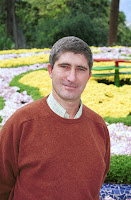Dr. Andrea Dieball, a supervisor on the School of Physics and Astronomy's Tenerife field trip is a Post Doc Researcher in Astronomy.
Andrea specializes in star clusters...these are star systems which are bound together by gravitational forces. She uses light from far Ultra Violet to Infra Red wavelengths to observe stars in globular clusters.
Globular clusters are the most dense and the oldest star systems that we find in the Milky Way. (Older than 10 billion years) - apparently the universe is about 14 billion years old! There are other types of clusters - for example open clusters which are less dense and younger. (As young as a few million years, but they can be as old as a few billion years - although older open clusters are rare). The Orion nebula is a star forming region with a young open cluster inside - called the Trapezium cluster.
Andrea did her German Diploma (like a Masters degree) and her PhD thesis on Star Clusters in the Magellanic Clouds. The Magellanic Clouds are two of our closest neighbouring galaxies - these ´Clouds´ are orbiting the Milky Way, and this has an influence on the gas found within the galaxies. Whenever they are close either to each other or the Milky Way the gas is disturbed and over time forms stars (less than a few hundred million years).
There is a theory that all stars are formed in star clusters, then the cluster disolves over time and the stars disperse, forming the field star population in the galaxy - these stars are not bound to each other by gravitational forces. Studying Star clusters is important because they trace the history of galaxies.
Andrea supervised the X-Ray Binary Group during the Design in Gamma Ray astromony course. One of Andrea's students said of her, 'she's excellent, terribly helpful and such a lovely person as well!
Andrea also acts informally as the field-trip nurse, looking after student and staff ailments alike.
 This image has been produced by Alex Terris, by data gathered from the Mons telescope in Izana, Tenerife during an astronomy field-trip.
This image has been produced by Alex Terris, by data gathered from the Mons telescope in Izana, Tenerife during an astronomy field-trip.













































